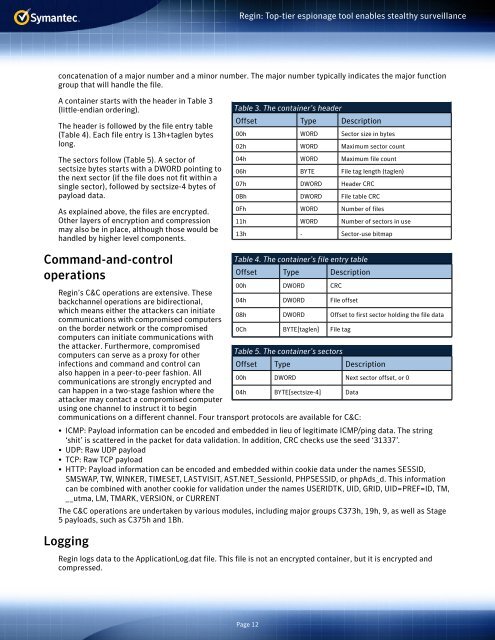Create successful ePaper yourself
Turn your PDF publications into a flip-book with our unique Google optimized e-Paper software.
Regin: Top-tier espionage tool enables stealthy surveillance<br />
concatenation of a major number and a minor number. The major number typically indicates the major function<br />
group that will handle the file.<br />
A container starts with the header in Table 3<br />
(little-endian ordering).<br />
The header is followed by the file entry table<br />
(Table 4). Each file entry is 13h+taglen bytes<br />
long.<br />
The sectors follow (Table 5). A sector of<br />
sectsize bytes starts with a DWORD pointing to<br />
the next sector (if the file does not fit within a<br />
single sector), followed by sectsize-4 bytes of<br />
payload data.<br />
As explained above, the files are encrypted.<br />
Other layers of encryption and compression<br />
may also be in place, although those would be<br />
handled by higher level components.<br />
Table 3. The container’s header<br />
Offset Type Description<br />
00h WORD Sector size in bytes<br />
02h WORD Maximum sector count<br />
04h WORD Maximum file count<br />
06h BYTE File tag length (taglen)<br />
07h DWORD Header CRC<br />
0Bh DWORD File table CRC<br />
0Fh WORD Number of files<br />
11h WORD Number of sectors in use<br />
13h - Sector-use bitmap<br />
Command-and-control<br />
operations<br />
Regin’s C&C operations are extensive. These<br />
backchannel operations are bidirectional,<br />
which means either the attackers can initiate<br />
communications with compromised computers<br />
on the border network or the compromised<br />
computers can initiate communications with<br />
04h<br />
08h<br />
0Ch<br />
DWORD<br />
DWORD<br />
BYTE[taglen]<br />
File offset<br />
Offset to first sector holding the file data<br />
File tag<br />
the attacker. Furthermore, compromised<br />
computers can serve as a proxy for other<br />
Table 5. The container’s sectors<br />
infections and command and control can<br />
also happen in a peer-to-peer fashion. All<br />
communications are strongly encrypted and<br />
can happen in a two-stage fashion where the<br />
attacker may contact a compromised computer<br />
using one channel to instruct it to begin<br />
Offset<br />
00h<br />
04h<br />
Type<br />
DWORD<br />
BYTE[sectsize-4]<br />
Description<br />
Next sector offset, or 0<br />
Data<br />
communications on a different channel. Four transport protocols are available for C&C:<br />
• ICMP: Payload information can be encoded and embedded in lieu of legitimate ICMP/ping data. The string<br />
‘shit’ is scattered in the packet for data validation. In addition, CRC checks use the seed ‘31337’.<br />
• UDP: Raw UDP payload<br />
• TCP: Raw TCP payload<br />
• HTTP: Payload information can be encoded and embedded within cookie data under the names SESSID,<br />
SMSWAP, TW, WINKER, TIMESET, LASTVISIT, AST.NET_SessionId, PHPSESSID, or phpAds_d. This information<br />
can be combined with another cookie for validation under the names USERIDTK, UID, GRID, UID=PREF=ID, TM,<br />
__utma, LM, TMARK, VERSION, or CURRENT<br />
The C&C operations are undertaken by various modules, including major groups C373h, 19h, 9, as well as Stage<br />
5 payloads, such as C375h and 1Bh.<br />
Logging<br />
Table 4. The container’s file entry table<br />
Offset Type Description<br />
00h DWORD CRC<br />
Regin logs data to the ApplicationLog.dat file. This file is not an encrypted container, but it is encrypted and<br />
compressed.<br />
Page 12


